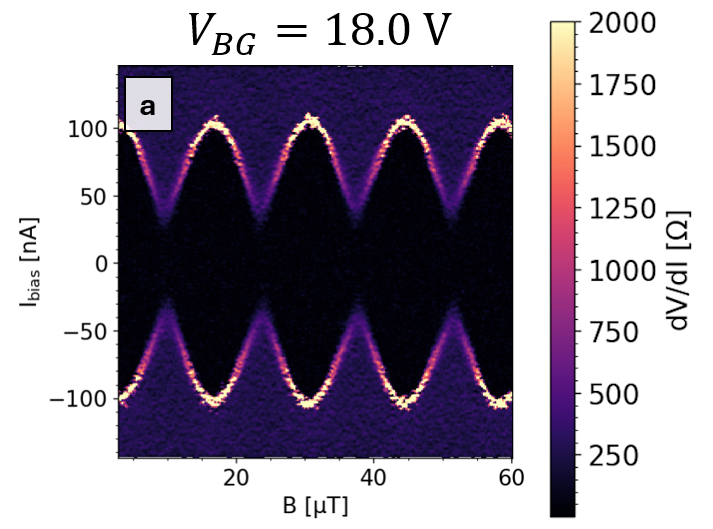Andrea Chieppa, Gaurav Shukla, Simone Traverso, Giada Bucci, Valentina Zannier, Samuele Fracassi, Niccolo Traverso Ziani, Maura Sassetti, Matteo Carrega, Fabio Beltram, Francesco Giazotto, Lucia Sorba, and Stefan Heun
Due to its large g factor and large spin-orbit coupling, superconducting-semiconducting hybrids incorporating InSb have been proposed as a platform to host topological superconductivity. Our recent work demonstrates the realization and characterization of superconducting quantum interference devices (SQUIDs) fabricated using Nb/InSb nanoflag/Nb Josephson junctions. Two SQUID geometries were investigated: symmetric and asymmetric, achieved by varying the width of the Josephson junctions (380 nm in the symmetric configuration, 530 and 1730 nm in the asymmetric configuration), keeping the same electrode distance of L = 200 nm.
The devices have been characterized at a temperature of 350 mK, where the induced coherence length in the nanoflags is such that the devices are in the short-junction regime. Under an external perpendicular magnetic field, periodic modulations of the supercurrent are observed (Fig. 1), as expected for SQUIDs. The shape of the interference patterns is found to be dependent on the back-gate voltage, a feature that, through numerical simulations, is linked to the transparency of the superconductor-semiconductor interface controlled by the back-gate.

When the applied magnetic field is such that the flux over the Josephson junctions is non-negligible (ΦJJ ∼ Φ0), the SQUID oscillations are superimposed on a Fraunhofer-like envelope (Fig. 2) due to quantum interference happening both at loop and Josephson junction level. Evidence of multiple interference minima is observed in the asymmetric SQUID, where one junction adopts a wide configuration, reflecting the influence of geometry on the supercurrent distribution. Nonreciprocal supercurrent transport is also detected, with a rectification efficiency of up to 6%. This diode-like behavior is gate-tunable and highlights the role of asymmetry and transparency in shaping the CPRs. Additionally, the SQUIDs operate in a non-hysteretic regime, enabling their use as magnetometers. A magnetic flux noise of S1/2Φ = 4.4 x 10-6 Φ0 / √Hz was extracted, indicating a sensitivity that is competitive with other state-of-the-art SQUID magnetometers.

Publications:
Andrea Chieppa, Gaurav Shukla, Simone Traverso, Giada Bucci, Valentina Zannier, Samuele Fracassi, Niccolo Traverso Ziani, Maura Sassetti, Matteo Carrega, Fabio Beltram, Francesco Giazotto, Lucia Sorba, and Stefan Heun: Unveiling the current-phase relationship of InSb nanoflag Josephson junctions using a NanoSQUID magnetometer, Nano Letters 25 (2025) 14412 – 14419.
Presented at:
Andrea Chieppa: InSb Nanoflags SQUIDs, PRIN Meeting, University of Genoa, Italy, 16 December 2024. [Talk]
Andrea Chieppa: InSb Nanoflags SQUIDs, University of Basel, Switzerland, 20 December 2024. [Talk]
Andrea Chieppa, Gaurav Shukla, Giada Bucci, Valentina Zannier, Samuele Fracassi, Simone Traverso, Niccolo Traverso Ziani, Maura Sassetti, Matteo Carrega, Fabio Beltram, Francesco Giazotto, Lucia Sorba, Stefan Heun: Superconducting Quantum Interference Devices based on InSb Nanoflag Josephson Junctions, 2nd Congresso Nazionale di NQSTI, Rome, Italy, 5-7 February 2025 [Abstract] [Talk].
Andrea Chieppa: Superconducting Quantum Interference Devices based on InSb nanoflags, Master Thesis Defense, University of Pisa, Italy, 15 February 2025. [Talk]
Matteo Carrega: Hybrid Josephson junctions based on InSb nanoflags, Mallorca Topological Quantum Matter (MTQM), Palma, Spain, 6-9 May 2025. [Abstract] [Talk]
Andrea Chieppa, Gaurav Shukla, Giada Bucci, Valentina Zannier, Samuele Fracassi, Simone Traverso, Niccolo Traverso Ziani, Maura Sassetti, Matteo Carrega, Fabio Beltram, Francesco Giazotto, Lucia Sorba, and Stefan Heun: Superconducting Quantum Interference Devices based on InSb Nanoflag Josepohson Junctions, European Conference on Innovative and Advanced Epitaxy, Pisa, Italy, 19 – 23 May 2025 (oral). [Abstract] [Talk]
Andrea Chieppa, Gaurav Shukla, Giada Bucci, Valentina Zannier, Samuele Fracassi, Simone Traverso, Niccolo Traverso Ziani, Maura Sassetti, Matteo Carrega, Fabio Beltram, Francesco Giazotto, Lucia Sorba, and Stefan Heun: Superconducting Quantum Interference Devices based on InSb Nanoflag Josepohson Junctions, Nanoscienze Institute 4th workshop, Modena, Italy, 5 – 6 June 2025 (poster). [Abstract] [Poster]
Stefan Heun: Superconducting Quantum Interference Devices based on InSb nanoflag Josephson junctions, First Symposium on Physics and Chemistry for Unconventional Computing, Krakow, Poland, 11 – 13 June 2025. [Abstract] [Talk]
Stefan Heun: Superconducting Quantum Interference Devices based on InSb nanoflag Josephson junctions, FisMat2025, Venice, Italy, 7 – 11 July 2025. [Abstract] [Talk]
Matteo Carrega: Hybrid Josephson junctions based on InSb nanoflags, E-MRS 2025 Fall Meeting, Warsaw, Poland, 15 – 18 September 2025. [Abstract] [Talk]
